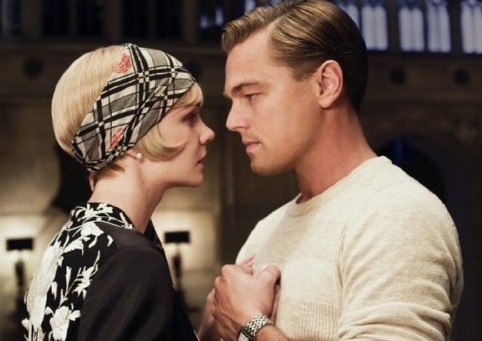For its first two thirds, Baz Luhrmann’s “The Great Gatsby” is busy busy busy with nary a minute to avoid an onslaught of stylized metaphors. People keep asking me Is it like “Moulin Rouge”? Well no, it’s not nearly as unruly because Luhrmann has to stick– more or less- to the F. Scott Fitzgerald text. He has a structure and a story and at some point he has to get with the program. And he does. The last third of his Gatsby is one of the most beautiful, moving films I’ve ever seen. And the first two thirds? They are a joyride through the director’s wild imagination.
So we’ve got Leonardo DiCaprio as the mysterious and pained Gatsby, Tobey Maguire as the narrator Nick Carraway, Carey Mulligan and Joel Edgerton as Daisy and Tom Buchanan. And then are the secondary roles: Elizabeth Debicki making quite an impression as golf playing Jordan Baker, Daisy’s friend; Jack Thompson (“Breaker Morant,” anyone?) as Nick’s doctor; and Isla Fisher and Jason Clarke as Myrtle and George Wilson. Everyone is quite good. The only real mistake—and it’s a doozy—is Indian superstar Amitabh Bachchan as the Jewish gangster from Chicago, Meyer Wolfscheim. I don’t know what anyone was thinking. Yikes. He stands out like a sore thumb.
Maguire as Nick, of course, has to carry the film. I’ve seen it twice and he is very strong. As in “The Cider House Rules,” Maguire plays a very good observer. (I laughed when Edgerton’s Tom said to Nick: “I know you like to watch.” That is really Maguire’s talent. He’s great at it.) Even though he was the hero in “Spider Man,” Maguire’s skill is in setting himself apart from a story. That makes him a ready-made Nick. He has some things to overcome though: This screenplay tries to make it out that the author of the book is really the main character, who has authored the story we’re seeing as a memoir. They tried this in “On the Road,” pretending Sal was Jack Kerouac typing furiously onto a scroll. It didn’t work there and it’s not such a good idea here. There’s nothing to suggest that Nick wrote a book about Gatsby after all the incidents of this story. It’s more than a little annoying but I guess they felt it had to be done as a framing device.
DiCaprio is the wild card here. After playing Hoover, and Hughes, and several patrician characters, I wondered if he could differentiate among all these similar voices. But Gatsby is more like a version of Frank Abagnale the pretender from “Catch Me If You Can.” Gatsby is a dreamer, he’s obsessed with Daisy, he’s unrealistic about his goals.
DiCaprio is an oddity in the film business. He’s the defacto leader of his generation of actors. He’s not a theater actor; he’s a movie star. But he gets lots of kudos. At 38, he gets Oscar nominations but no Oscar. His Gatsby probably won’t get him that Oscar. but he’ll get close. He begins as a ghost, to Daisy, to us. But as he gets fleshed out, this Gatsby has a lot of pathos. He’s doomed. We know it, he doesn’t. And I think DiCaprio can be very proud of this performance..
As for the other actors: as Daisy, Carey Mulligan is spot on as she draws Gatsby out. She’s a much stronger Daisy than Mia Farrow in the original film. She’s not nearly as fragile as Daisy in the book. But that makes her a little more relate-able for 2013. Edgerton is superb as Tom Buchanan, an utterly reprehensible person who in this iteration looks a little like Hitler with his small mustache. There’s no question that you’re rooting for everyone, not just Daisy, to get away from him.
But Fitzgerald purists beware: there’s a “Rosebud” moment you will have to ignore because a) it’s invented and isn’t from the book and b) it’s sort of ridiculous and underscore the movie’s failings. In this film, Gatsby’s death is punctuated, Nick says, by him uttering one word: “Daisy.” Really? Gatsby is about class and ambition and arrogance. Daisy is collateral damage, a means to an end. The movie doesn’t understand this. And the book’s sad funeral for Gatsby, the arrival of his father from the midwest– is dismissed in a narration. The great tragedy of Gatsby is missed, sacrificed to the secondary story of a love affair gone wrong.
Otherwise, “Gatsby” is all about design and style. There’s lots of it, all skillfully executed. Butlers emerge in the Buchanan foyer in choreographed lockstep. When we meet Daisy, white sheets flap all around her in her sitting room. Gatsby tosses down his beautiful expensive handmade shirts from his dressing room down on to Daisy—the second time she “drowns” in luxury. Gatsby’s guests must drive from New York through piles of sand and landfill—the gritty world of gas stations, construction, and the approaching modern world—to find his mansion that looks like Disneyland on steroids.
I was thinking about “Mad Men” when I was watching “Gatsby” for the second time. Don Draper is not going to live past the 1960s. In the same way, Gatsby and his pals could never possibly have faced October 1929 and the end of their lives. They are not prepared for the Thirties, the Depression, and war. This is their last gasp. And even though the movie is a roller coaster for quite a while, when it stops, and there’s quiet—that single idea still resonates.

